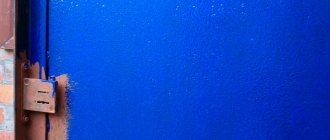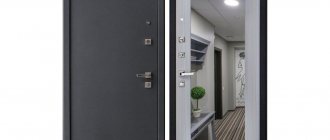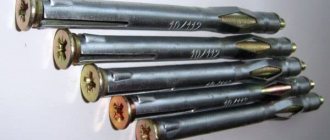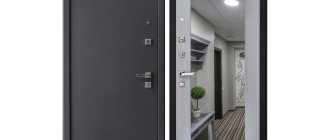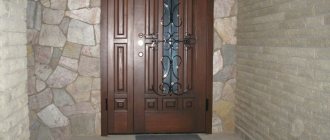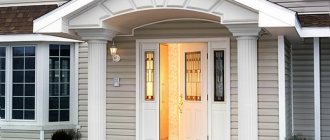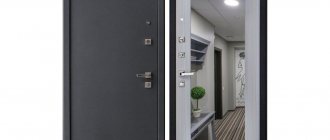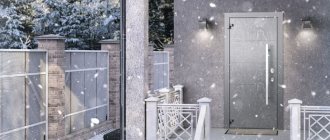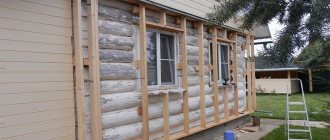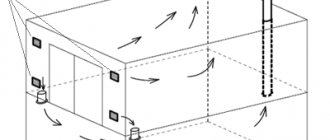Choosing a material for insulating a metal entrance door
You cannot begin work without it, which is why you first need to decide on the best option, having previously examined each of them in more detail and purchase it. There are a large number of different insulation materials on the market, making it quite easy to choose the one that suits the cost and technical parameters. For thermal insulation, you can use not only hard but also soft materials.
Mineral and stone wool
Mineral wool is in quite significant demand on the market among consumers, which has an affordable price, perfectly absorbs noise, has the ability to restore its original dimensions after compression and, due to its soft structure, is easy to use. This insulation withstands temperature fluctuations, providing complete protection of the building from the penetration of cold into it, and it is also environmentally friendly, non-flammable and allows you to vary the installation height without the need for additional cutting.
Mineral wool is supplied for sale in rolls and sheets, which makes it possible to cut blanks of the required size, which are placed in cells created by the stiffening ribs of the door structure itself. To obtain the required thickness of the insulation, you only need to press it down (pressure), which in the end will in no way negatively affect the technical performance.
The disadvantages of mineral wool include softness, which leads to shrinkage over time, but this disadvantage can be easily eliminated by creating stiffening ribs in the door structure, which prevent the material from slipping over a long period. Its significant disadvantage is its poor resistance to the influence of moisture, often acting as condensation, which occurs due to a shift in the dew point inside the door leaf. To perform high-quality insulation and avoid this drawback, it is better to give preference to stone wool.
Unlike mineral wool, it withstands its impact and allows for effective thermal insulation even of the entrance doors of private houses. In another situation, mineral wool may be a suitable option only when insulating structures that are installed in heated vestibules or corridors of apartment buildings, as well as when additionally installing a waterproofing film inside it.
Foam plastic and penoplex
Preference is given to it quite often, since the insulation has insignificant weight, which does not lead to significant weighting of the door. The material has an optimal level of strength and excellent wear resistance, and due to its hygroscopicity, it does not require additional waterproofing. In addition, polystyrene foam has high soundproofing and thermal insulation properties, thanks to which it is possible to reduce noise levels and increase heat retention inside the house, as well as prevent the penetration of cold from the street. When choosing it, you should give preference to penoplex, which, unlike ordinary material, has a higher density, which is why such insulation, even of a finer thickness, has similar qualities as ordinary sheets of standard polystyrene foam. When using it as thermal insulation, it is advisable to additionally seal all seams with polyurethane foam to prevent the formation of cold bridges.
Note! It is not recommended to use ordinary polystyrene foam for insulation, since when heated it can release substances hazardous to health.
Polyurethane foam (polyurethane foam)
Not quite a traditional option for insulating doors, but which also has a number of positive qualities and even surpasses other materials in some respects. Initially, in order to obtain an effective result, you need to be able to correctly use a spray foam gun or the tube supplied with the container, thanks to which you will not only be able to complete the work fully, but also avoid spraying an excessive amount of excess.
The material itself, due to its airy structure, does not significantly increase the weight of the door leaf, withstands temperature changes and exposure to moisture, and if you know certain nuances, it is quite simply applied and evenly fills all voids, including hard-to-reach areas.
Things to consider
From the point of view of effective thermal insulation, the quality and price of the purchased door are not the main success factor. If there are violations associated with cold bridges, no amount of fabric replacement will help. Just as in the case of a wooden door, you need to completely solve the problem of blowing cold in the area between the frame and the leaf.
Please note that much of the success depends on good heat treatment of the through gaps. Pay attention to which side of the canvas you are installing the mineral wool on. If you place the filler outside, then all the condensation will evaporate outside, and not into the room. This way you will protect yourself from excessive humidity and dampness.
Insulation of the door frame
Insulation of a metal entrance door should begin with the elements of the frame. If the box is made from a corner, then insulation is possible only in the places where the box adjoins the doorway. In this case, the gaps are filled with foam, and the excess insulation is cut off with a construction knife. If the box is made of a rectangular or square pipe, the insulation is placed inside the profile.
The better to insulate
To insulate the door frame, use foam or bulk insulation (sawdust, expanded clay).
Polyurethane foam is used to eliminate gaps between the frame and the doorway, as well as to fill the cavities of frame elements made from profiles.
Bulk insulation is used only for profiled frames. The profile is filled through a technological hole drilled in the upper part of the box. The diameter of the hole should allow the largest fractions of filler to pass through.
This method has a significant drawback: it is impossible to ensure that the entire internal space of the box is filled with bulk materials. As a result of uneven filling, voids are formed that freeze. Therefore, the use of bulk insulation is possible only in production conditions, when assembling the box in the workshop.
Materials and tools
To insulate the box you will need the following tools and materials:
- electric drill;
- metal drills with a diameter equal to the diameter of the nozzle of a cylinder with polyurethane foam;
- polyurethane foam;
- construction knife.
Insulation instructions
To fill the door frame with foam, you will need to prepare technological holes with a pitch of 500 mm. Through these holes, the internal space of the profile is filled with polyurethane foam. Excess foam coming out through the holes must be removed with a construction knife.
The gaps between the door frame and the doorway are cleaned of old insulation, moistened and filled with polyurethane foam. Excess foam is removed using a construction knife, after which the contact point between the box and the wall is masked with putty.
When do you need to insulate?
Wood has low thermal conductivity, but the disadvantage of the material is its response to changes in humidity and temperature. The door block dries out, swells, warps and even cracks. There are three main reasons signaling the urgent need to insulate a wooden door in a country house:
- Formation of gaps between the frame and the ends of the opening walls . Initially, during installation work, all gaps are foamed. Foam is a good insulator, but over time it loses its properties. Destruction occurs faster on the street side if platbands are not installed. Foam deteriorates from exposure to the sun. Another cause of cracks is the misalignment of the bowl.
- Formation of gaps between the frame and the sash . The most common defect in a wooden entrance door occurs due to poor wood, poor-quality installation and long-term use. Often the owner himself becomes the culprit when he trims the swollen sash so that it closes better. After drying, the product decreases in size and a gap forms.
- Wear of insulation. Each thermal insulation material is selected taking into account operational requirements. If they were not initially followed, the incorrectly selected insulation loses its effectiveness. For example, mineral wool quickly cakes, and due to dampness it decreases in volume. Any old wooden door, as well as a thin leaf, needs to be insulated.
Eliminating Gaps
Heat loss occurs not only through a metal leaf or door frame. During the installation of the structure, a so-called technological gap is created - a gap between the wall and the box, usually its dimensions are about 2 cm. For insulation work, it is best to use polyurethane foam. Simply covering the cracks with cement is not a solution, since such a mixture is not a heat-insulating material. It does not protect the room from the cold, but shrinks over time.
Thermal insulation of the technological gap must be carried out in the following sequence:
- From the side of the room, remove the casing in the place where the box comes into contact with the wall. Secure the polyethylene film.
- Remove the casing from outside the apartment. Moisten the space in the crack with water. You can use a spray bottle. This is necessary so that the polyurethane foam hardens much faster.
- Apply the first thin layer of foam. Its path should be uniform, without breaks or omissions.
- After about 20 minutes, when the first layer of foam expands, apply a second ball of it. It is necessary to ensure that the substance does not bleed beyond the perimeter of the door frame.
- When the foam has completely hardened, remove the polyethylene film that served as protection from inside the apartment.
- At the end of the work, install the platbands in place.
If the foam appears a little outside the box, it’s not a big deal. It must be carefully cut with a construction knife.
Common Mistakes
Let's briefly talk about what not to do and how to avoid being a victim of failure:
- Foam insulation. When choosing a material for sealing the joint between the door and the frame, abandon the idea of foam rubber parts. The reason lies in the fact that this filler quickly breaks down and loses its properties. And if the “guard” is used frequently, the insulation will need to be replaced after a couple of months of winter.
- Foaming the box. Polyurethane foam, like nothing else, is suitable for insulating hard-to-reach places, including door frames. But do not overdo it when applying liquid to the surface!
If this is your first time touching a can, remember that the foam significantly increases in volume after sealing.
In this case, the insulation will end up in all possible places: from wallpaper to the insides of mechanical locks. Otherwise, you will have to deal not only with insulation, but also with parallel repairs.
That's all! Now, you can independently check in practice how to insulate a door with your own hands, and create comfort in your home and family budget.
Seal installation
Another weak point in the design in terms of heat loss is the area where the sash comes into contact with the frame. If it does not fit very tightly, a draft will appear. This problem can be eliminated by installing a seal. It is produced in the form of a self-adhesive tape, which can have a different profile (section).
If the gap is small, then an oval or round seal will be useful.
If the gap is more than 3 mm, then it is worth buying a tape with a cross-section in the shape of the letter P.
Before insulating a metal entrance door, in addition to the seal itself, for insulation work you will need to acquire scissors and some kind of solvent to degrease the door.
The scheme of work is as follows:
- If an old seal was installed on the door, it must be removed and the surface thoroughly cleaned.
- Degrease the area for the tape using a solvent.
- Glue the seal around the perimeter of the sash, retreating approximately 3 mm from the outer edge. In this case, the tape must be pressed well to ensure good adhesion (without waves).
Do not pull the tape too tightly while gluing. Otherwise, it will not adhere well to the surface of the door and may come off. It is not recommended to purchase a seal that is too thick, as this may cause the door to open and close poorly.
Clearance seal and door interior trim
When your canvas is ready for installation, begin twisting strips of leatherette and insulation to join the door.
To get such a detail, you need to wrap the filler in a tube made of leatherette. The shape will resemble shawarma or sushi! With their help, the entrance will be tightly closed, leaving no space for through jambs.
Rolls can be secured using standard methods - nails or paper clips.
You should end up with a box with leatherette lining on all sides, which will insulate the heat escaping from the house and will tightly secure the ajar door when closed.
How to insulate a door frame?
Many people think that to insulate a metal entrance door it is enough to insulate only the leaf. But in fact, the box also needs insulation. If it is made of a metal corner, then insulation can be done only along the perimeter where it adjoins the opening. To do this, just blow out all the cracks with foam. When the substance hardens, the excess can be cut off with a knife.
In the case when the box is made of a square or round pipe, then insulation can be placed inside it.
Suitable for these purposes:
- Polyurethane foam. It is convenient to seal the gaps between the wall and the frame, as well as fill all the cavities of the door frame.
- Bulk materials. This could be expanded clay, sawdust. To do this, make a hole in the profile and fill it with filler. If you perform this procedure yourself, then not all voids can be filled with material. Thorough insulation is only possible when the box is manufactured in a factory.
But you can try to do the insulation yourself. To do this, you will need a drill and suitable metal drills, the insulation itself (spray foam), and a knife.
Completing of the work:
- Holes are made every 50 cm.
- Using them, the cavity inside the box is filled with foam.
- All of its excess that has emerged through the holes is cut off with a knife.
- The gaps between the opening and the box are also filled with foam.
- When the substance becomes hard, it is cut and puttied.
Internal and external insulation of a metal door will reliably protect the room not only from thieves, but also from frost. You can carry out insulation work on your own by placing suitable material on the outside or inside of the sash. You should also take care of insulating the box and gluing the seal. Only a set of measures will prevent heat loss.
How is heat lost?
Pay your attention first of all to the main line of defense - the entrance doors. If there are gaps between the door frame, then no amount of batteries will protect you from cooling outside.
A draft makes its way into the house between the jambs and sagging doors, which are formed for a number of reasons.
There are 3 main types of thermal insulation failure:
- Gaps between the boards of the door leaf. The space can be created by the expiration of material or padding, which creates cold bridges through which the cold enters directly into the house. To avoid this problem, remove these boards when adding filler and cover empty cells with it.
- The gap between the box and the canvas. It appears due to frequent use, poor quality material or installation.
It is highly not recommended to buy a wooden entrance door made of pine and spruce, because this material tends to dry out quickly. But doors made of dark exotic woods will serve you for decades.
Also, be careful during installation, because a few carelessnesses and you will have to re-cut and align the openings.
- Gaps between the opening and the wall. A common problem in older homes and damp areas. Over time, the material dries out and thermal insulation failure occurs. The problem is solved by using polyurethane foam, but only with precise and dense placement of the platbands. If you install them loosely, the foam collapses and loses its protective properties.
When you are completely sure that the source of the cold has been eliminated, then start insulating the wooden door!
Do-it-yourself insulation of a metal entrance door
The process begins with the selection of the optimal thermal insulation material, which determines the effectiveness of insulation and its duration.
How to insulate a metal door
Types of insulation:
Penofol
Thanks to the reflective ability of the foil layer, it retains almost all the heat in the room. Used only as additional material.
Insulating a metal door with penofol
Rigid insulation
These include polystyrene foam and expanded polystyrene (penoplex). Their advantage is ease of installation and relatively low price. Since it is not hygroscopic, it does not require additional films. This is the only suitable option for installation in a cottage, country or rural house. Indeed, in this case, the door serves as a barrier to low temperatures and wind, which is not observed in apartment buildings where the door opens into the entrance.
Insulation of a metal door with polystyrene foam and polystyrene foam (penoplex)
Note. When choosing thermal insulation material, give preference to penoplex (expanded polystyrene). It is an order of magnitude denser than polystyrene foam and will provide the door with much more effective insulation.
Soft insulation
This category includes glass wool and mineral (basalt) wool. Their difference is only in the raw materials; in terms of their thermal insulation characteristics, they are not very different. Mineral wool is characterized by environmental friendliness, fire safety, and the ability to vary the installation height without additional trimming.
Cotton wool is sold in rolls or sheets, which makes it possible to cut blanks of the required sizes from it and place them in cells formed by the stiffening ribs of the door itself. To ensure the required height (thickness of insulation), simply press down the material (press cotton wool), the thermal insulation properties will not be affected.
But cotton wool has a drawback that prevents it from being recommended for installation in iron doors for private homes. Because There are different temperatures on different sides of the door, and sometimes the difference is up to 40 °C (-15 outside and +25 in the house). This leads to a shift of the dew point inside the insulation, and the wool gets wet. The effect can be neutralized by installing a hydrobarrier film.
But, nevertheless, professionals do not recommend insulating an iron door with cotton wool in a private house. It can become an acceptable option only if the entrance door to the apartment is insulated, since in this case there is not such a big difference in temperatures (it is much warmer in the entrance than outside).
Insulating a metal door with mineral wool
Inflatable insulation
Presented with polyurethane foam. Spraying makes it possible to fill all the cracks, but has a high price.
Insulation of a metal door with polyurethane foam (PPU foam)
Thermal insulation of luxury metal doors is carried out using three types of materials: foam plastic (main material), penofol (additional), polyurethane foam (filling the voids of the stiffeners and frames).
Note: a set of materials that can be found in stores is of little use for insulating an external metal door, because They use dermantin, foam rubber or synthetic winterizer as insulation.
Installation of double doors
A good way to insulate your home is to install a double entry door. Due to the formation of an air space separating the room from the street, heat is retained. The disadvantage of this design is the reduction in space.
A threshold is set for the indoor unit. Insulation is additionally laid on the slopes between the doors. There are designs where two doors are hinged on one deep frame.
When insulating entrance doors, you must remember that moisture affects the canvas from the street side. Treatment with impregnation, painting with paint or varnish will help protect against dampness as much as possible. Drying oil creates good waterproofing.
Source
Step-by-step instructions for insulating a wooden door in a private house
The work is carried out taking into account the characteristics of the entrance group and the installation technology of the selected insulation.
Tools and materials
In the process of working, the following set of tools, devices and materials is required:
- nail puller, pliers;
- screwdriver, hammer;
- hacksaw, jigsaw;
- tape measure, stationery knife, scissors;
- construction stapler.
It is also necessary to prepare the estimated amount of insulation, sealant, sheathing material and fasteners.
Preparatory work
At the preliminary stage, the following work is performed:
- remove the door leaf;
- unscrew door fittings and hinges;
- remove the casing, if present;
- remove old insulation and sealant residues.
Next, the canvas and box are checked for structural defects, distortions and other defects are eliminated.
Cutting and laying insulation
Based on the measurements, blanks of the required sizes are made. When arranging a frame structure, the voids are tightly filled with layers of insulation. The material is fixed using a construction stapler.
Door trim
Dermantin is mainly used as a finishing layer. The upholstery fabric should be cut taking into account a margin of 10 cm on the sides in order to create the necessary thickening around the perimeter. The upholstery is secured with decorative nails and cord to form a distinctive raised pattern. Next, install the door hardware.
The surface of the door leaf is lined with artificial leather from the inside
Seal installation
To eliminate gaps, use self-adhesive strips or install a harpoon seal. Thanks to the special shape, the product fits as tightly as possible to the base, ultimately eliminating the risk of drafts and reducing the level of heat leakage from the room.
Additional measures and means of hydro- and thermal insulation
For maximum quality insulation of a street door in a private house, the joint around the perimeter of the frame is equipped with dermantine rollers with a foam insert inside. It is recommended to line the surface of the entrance sheet with artificial leather from the inside. From the outside, the structure is sheathed with a material that is highly resistant to aggressive atmospheric influences.
Sealing with rollers
The upholstery of a country house door from the outside must be completed by installing special rollers. To make them, you will need to cut 4 strips 10 cm wide. The length of 2 strips is equal to the width of the wooden panel with an allowance of 10 cm. The other 2 parts are cut according to the height measurement, not forgetting to leave the same allowance (10 cm).
It is necessary to cut strips from foam rubber or other filler, the length of which corresponds to the length of the leatherette parts, and the width is 2-3 cm less. You can insulate wooden entrance doors with rollers both before and after installing the paneling.
Installation
Place the previously prepared leatherette parts along the edge of the door: long strips in height and short strips in width. Laying is done inside out so that the edge of the strip is at a distance of 1-2 cm from the edge of the wooden base. Fastening can be done with staples of a construction stapler or small nails with an enlarged head (upholstery nails). The fastening pitch is 10-15 cm along the entire perimeter of the canvas.
For better thermal insulation of doors, a strip of insulating material should be laid on a nailed strip of leatherette, 1 cm away from the edge. Bend the roller lengthwise in half so that the insulation is inside the upholstery. Tuck in all free edges and secure the edge of the roller to the wooden panel with decorative nails.
The fastener also performs a finishing function. Nails can be driven in at random intervals and even close to each other, but you need to ensure that they are evenly placed. The installation is completed by fastening the previously removed fittings: you need to cut holes for the handles, and fasten the locking plates over the upholstery.
Stages of plating an iron model
The sequence of actions when covering an old door depends on its design. If the design is more modern and the metal panels are attached to the base with screws, the insulation is done internally. When starting internal insulation, we remove the metal structure and place it on a work surface. Unscrew the screws and remove the metal panel (to ensure that the screws unscrew well, lubricate them with machine oil). Using a tape measure, take the dimensions of the internal cells of the door.
Carefully measure the insulation material and cut it off. Be sure to cut out a place for the door lock and peephole. For old doors, polystyrene foam or foil-lined stone wool are great. We treat the inner surface of the old structure with glue (liquid nails) and glue the prepared insulation. If there are any gaps between the old door and the insulation, fill them with foam. You must work carefully, squeezing out the mounting foam in small portions. It is important to ensure that it does not get on the bolt lock mechanism. For additional sound insulation, we lay foil insulation between the insulation and the metal sheet. We cover the structure with a metal sheet and screw in the screws.
If the old door is made by fixing metal panels by welding, then we proceed to insulate the old door using the external method. We prepare wooden blocks 20 (30) x 20 mm. We measure the parameters and cut the slats to the required length. Using a drill, we make holes for future fastening in the metal sheet. We assemble the base from prepared wooden blocks and fasten it to a metal sheet with self-tapping screws.
We prepare insulation according to the specified dimensions. We line and glue the insulation into the cells between the slats. We fix the MDF panel or board with screws. Additionally, for sound insulation, the door can be treated with leatherette from the outside or inside. To do this, we bend the leatherette and fix it with staples. Lubricate the lining and hem of the leatherette with glue (liquid nails) and press firmly against the metal sheet. This work is painstaking. At the last stage, we install door locks, handles, and a peephole. We return the finished door to its place.
When covering a single-layer metal door, it is necessary to measure the cells between the stiffeners. We cut the inner material to the specified size. We quickly glue the insulation into the cavity. We eliminate cracks and small gaps using polyurethane foam. We decorate with MDF panel.
Tools and materials
When you have finally decided which filler to use to insulate the doors, it’s time to prepare all the necessary tools:
- hammer;
- decorative nails;
- measuring instruments (tape measure, ruler, pencil);
- wood saw;
- sharpened knife for cutting;
- stapler and staples;
- pliers or nail puller;
- sealing tapes.
The list is impressive, but all items are necessary. And for this case there is an English proverb - “Necessity is the mother of invention.”
It is best to choose a leather substitute for upholstery. This material has many advantages: moisture-resistant, tension-resistant and easy to clean. Plus, it's available in many hardware stores and chain stores, so your search won't take long!
Beautiful ideas
The appearance of the front door always emphasizes the status of the owner. Therefore, in a private home the requirements are especially high. Here it is important to take care of a decent image. The market for metal doors is saturated with a variety of products. Another good thing is that doors can be ordered according to a personal project.
And yet, how nice it is to work on the design yourself! We offer several ideas for decorating metal doors with your own hands. The design of a door in an apartment is interesting because the outside can be decorated so as not to attract other people's attention. The simplest, most affordable way is to decorate a metal door with bright fittings. You can attach new numbers to the outside, add stylized handles, hinges, and locks.
For those who prefer natural materials, we can recommend covering the inside of the door with MDF panels or simple wooden slats. The design and color of the metal door of a private house, as well as the shape, depend on the style in which the house or cottage is built. For fittings, you can use forged parts, stained glass windows, glass inclusions. And instead of a modern bell, you can hang a knocker or gong.
Upholstery fabric
At this stage, insulating a wooden entrance door with your own hands consists of several separate operations:
- Materials are cut according to previously taken measurements of width and length. The insulation must be cut without an allowance, and decorative upholstery, if necessary, is cut with an allowance for tucking the edges (1-1.5 cm). It is necessary to tuck the edge when the sealing rollers are not installed. This is what they do if they perform internal insulation of the wooden entrance group of an apartment with insulation and leather.
- Installation of insulation consists of attaching it to a wooden door leaf. To do this, you can use glue, a construction stapler or wallpaper nails. The cut out rectangle needs to be aligned and attached to the canvas, leaving the edges of the material free for tucking the sheathing under them.
- The leatherette part is placed on top of the insulation and smoothed. Upholstery material must be attached from the middle of the fabric. If you want to make a decor, then its design is marked out in advance, and when attaching the upholstery, a fishing line is pulled between the nails along the intended lines. The edges of the upholstery must be tucked under the insulation and nailed with decorative nails at even intervals along the entire perimeter.
Improving the characteristics of Chinese products
The Chinese-made door is a non-demountable structure. To insulate it, remove the door and place it horizontally. We remove the handles, peephole, locks. Then we begin to attach the frame and stiffeners to it, both from the inside and from the outside. Therefore, we choose a wooden beam with a thickness of 20 * 20 mm, or more (we start from the thickness of the insulation material). If desired, you can weld a metal base, attach it with self-tapping screws or weld it to the door leaf, and fill the joints with polyurethane foam.
The next step is laying insulation. If fibrous materials are selected (mineral wool, stone wool), we lay out a water-repellent material larger in size than the base cavities, approximately 200 mm, secure with glue (liquid nails) and line the wool, having previously cut out a canvas slightly larger than the size of the base cells, and cover with another layer of water-repellent material. We fold the edges of the film tightly onto the top layer and secure with tape.
We cover the insulation with foil isolon or penofol with the foil side facing the room. This will improve the soundproofing qualities of the door. Polystyrene foam, expanded polystyrene, polystyrene, foil-coated isolon do not need waterproofing, since they themselves have water-repellent properties. Next, use a tape measure to measure the distance between the stiffeners, cut the insulation a little larger than necessary to avoid the formation of a cavity between the insulation and the base of the door. We glue the insulation into the cavity with glue (liquid nails).
We coat the base attached to the surface with mounting foam at the joints. The next step is to decorate the structure with an MDF sheet, panel or alternative material. It is important to remember that the decorative panel must be attached from the bottom up. We secure it, install locks, a peephole and handles, and hang the door. Now the door keeps the house warm and also protects from noise.
Conclusion
As you can see, insulating doors is not such a difficult task; the main thing here is to correctly determine the sector of arrangement, and the process itself is often not particularly difficult.
If you really want, you can insulate any entrance door with your own hands.
Source
Tips and tricks
The following recommendations should be followed:
- It is best to insulate a plastic door with glass, using an additional double-glazed window;
- it is necessary to pay equal attention to both the insulation of the canvas and the thresholds and the perimeter of the doorway;
- standard Chinese metal doors immediately need to replace the insulation.
The front door requires special attention when protecting from the cold. The entire perimeter should be insulated, and the door should be closed tightly and quietly using a seal. The insulation process for doors made of plastic and metal with wood is different.
Installation of hinges and fittings
When the canvas gets a new appearance, you need to put the removed fittings back in place. The hinges must occupy their nests exactly as they were installed before work began. The seat for the lock must be carefully cut out so that there is no damage to the upholstery of the door leaf around it.
If necessary, insulation can be combined with replacing the lock on the front door.
The insulated door is mounted back
Insulation materials
To insulate doors, ordinary cotton wool is often used. This material has been used for a long time, but it has significant drawbacks. It absorbs moisture, which creates ideal conditions for the proliferation of microorganisms. In addition, wool can move under the sheathing, which leads to the formation of uneven surfaces.
Foam rubber
Therefore, instead of cotton wool, it is better to use another popular insulation material - foam rubber. It is practical and easy to use. Foam rubber is well attached to the surface with glue or nails. Its disadvantage is that after a year it begins to crumble under the influence of moisture.
Izolon
The next common material is isolon. It costs more than foam rubber, but has better heat-protective properties. Its main advantage is that it is possible to obtain good thermal insulation performance using a material of minimal thickness.
Fillers
In addition to the above materials, silicone fillers and mineral insulation are used. Silicone fillers are resistant to external influences, but do not provide the required level of sound insulation. Mineral insulation is the most functional, environmentally friendly and safe for health.
Criteria for choosing building materials
If you carry out insulation yourself, it is preferable to purchase a self-adhesive version. Craftsmen advise having foam rubber or felt available. Using them is not difficult. A sash equipped with this gasket can be closed without any effort. The sealing material – rubber is characterized by high wear resistance.
Soft rectangular, tubular rubber seals are also in demand. Their service life is 5-7 years. They protect the room from odors and extraneous noise. The thermoplastic-based profile is resistant to temperature changes.
Craftsmen focus on the choice of filler for insulating the sash and the space around the frame. This process must be conscious, since it is difficult to change them. When choosing, you need to pay attention to the thermal conductivity coefficient. It determines how the material will handle heat retention. For wooden products, thin fillers are a good option. The use of soft insulation greatly simplifies the work. Its advantage is that it covers the surface with a margin and shrinks as much as necessary. It is important to measure the thickness and dimensions of individual structural elements with increased accuracy.
Metal
Metal entrance doors are made from a corner or square pipe. The door leaf has a cavity inside, which is filled with heat-insulating material during the insulation process. This can be polystyrene foam, the thickness of which should correspond to the depth of the cavity.
The foam is placed inside so that there is no free space. Insulation will be more effective if the thermal insulation material is attached using liquid nails. If after installing the insulation there are gaps in the cavity, they must be eliminated with polyurethane foam.
After the foam has dried, the laminated fiberboard is installed using metal screws. To make the screws screw in better, drill holes of the required diameter. Fiberboard is fastened from top to bottom so that the sheet is leveled during installation.
Insulation with sealing rollers
In those situations in which it is not possible to remove the structure from the hinges, upholstery is done with rollers. In this case, the insulation is wrapped in dermantin. It is necessary to nail from the side from which the material is folded in half.
It is important that the structure fits tightly to the rollers. They do not need to be nailed to the threshold, as they will wear out quickly. This must be done relative to the bottom edge of the door.
Entrance to the balcony
Insulating doors on a balcony can be done in the same way as thermal insulation of wooden entrance doors. If the balcony door has a window, then leatherette rollers filled with foam rubber are installed around its perimeter. It is not advisable to place the roller on the side with the hinges, as it will bend when opened. The gap between the hinge part of the balcony door and the frame is best sealed with foam tape, which is glued to the frame.
These works significantly reduce heat loss due to cold air coming from the balcony. If you fully insulate the balcony, heat loss can be minimized.
Work on insulating interior, entrance, and balcony doors in an apartment, house or country house, carried out in accordance with the necessary requirements, provides warmth, comfort and coziness for a long time.
Source
